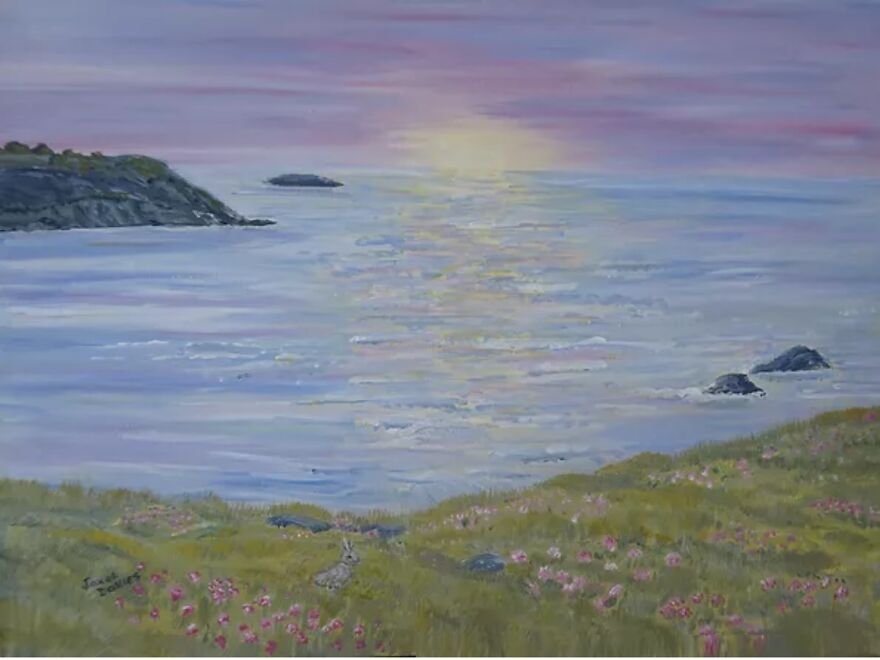Sunrise Seascape, With Painting Tips For Beginners
·
Painting tips, for beginners, in Acrylics.
First, choose your materials. Acrylics can be bought in a range of qualities and thicknesses. If you are just starting out or perhaps thinking of switching from watercolour or oils, you may want to choose student acrylics or some very cheap alternatives. As you progress I would advise professional artist quality. These won’t fade over time and give better results.
Basic started kits can be bought very cheaply and are sufficient to begin with as you can mix many other colours from them, and it is good to experiment. Have a small sheet of paper, paint a little patch of colour, and write under it what colour you used. Then mix with another colour and paint another patch, writing under that which two colours you used. Keep experimenting, writing down what you used and possibly how much of each, half and half, or whatever. Keep the test paper with your paints.
Next, choose your brushes. I would not advise expensive brushes or very cheap ones. If you were painting in watercolour, more expensive brushes are worth it. Acrylic will wear them out quickly and there are no advantages, in my opinion. On the other hand, very cheap brushes usually lose hair. If you want to cover a large area, decorating brushes can save you some money, but again, not the cheapest, unless you want lots of hair texture all over your painting.
Now choose is what surface to paint on. Paper will be the cheapest option. Acrylic can be used on paper, canvas, canvas board, hardboard, pebbles, almost anything. The paper needs to be 300grams, especially if you intend to water down your paint, for washes or to paint in a watercolour style. Thinner paper is said to be suitable for acrylic, on the cover, but you will be disappointed if it buckles.
I like to use a stay wet pallet. I bought a plastic container, approx. 8″ x 10″ and 3″ deep, and line it with ‘Sta-Wet’ pallet paper. You can buy the Sta-Wet palette, which is larger, but I find these tip over in my art bag when I am off to an art group or to sit out somewhere and paint. A money-saving tip here is to buy Non-stick baking & greaseproof paper from a supermarket and cut it into pieces to fit your palette for the top layer. Morrisons, in a green packet, works best. I usually find the top layer is used up sooner than the lower layer. You can use an old plate or disposable palette paper sheets, but acrylic dries quickly and if you wet the lower layer of the Sta-Wet paper, your paints will stay usable for days, depending on the climate.
So, you have your paints, brushes. palette and a surface to paint on. Most surfaces ready-made for acrylics, watercolour and oils are ready to paint on. If you are using hardboard panels from an art shop these are ready to use. You would need to paint both sides of any hardboard panels intended for carpentry and building, with Gesso primer, readily available in artist materials shops. Please watch my YouTube Videos for painting demonstrations and tips. Go to the video page, by clicking MORE on the bar at the top of the page where you will see. Youtube painting tips
www.artjandavies.com
More info: artjandavies.com

·
Painting tips, for beginners, in Acrylics.
First, choose your materials. Acrylics can be bought in a range of qualities and thicknesses. If you are just starting out or perhaps thinking of switching from watercolour or oils, you may want to choose student acrylics or some very cheap alternatives. As you progress I would advise professional artist quality. These won’t fade over time and give better results.
Basic started kits can be bought very cheaply and are sufficient to begin with as you can mix many other colours from them, and it is good to experiment. Have a small sheet of paper, paint a little patch of colour, and write under it what colour you used. Then mix with another colour and paint another patch, writing under that which two colours you used. Keep experimenting, writing down what you used and possibly how much of each, half and half, or whatever. Keep the test paper with your paints.
Next, choose your brushes. I would not advise expensive brushes or very cheap ones. If you were painting in watercolour, more expensive brushes are worth it. Acrylic will wear them out quickly and there are no advantages, in my opinion. On the other hand, very cheap brushes usually lose hair. If you want to cover a large area, decorating brushes can save you some money, but again, not the cheapest, unless you want lots of hair texture all over your painting.
Now choose is what surface to paint on. Paper will be the cheapest option. Acrylic can be used on paper, canvas, canvas board, hardboard, pebbles, almost anything. The paper needs to be 300grams, especially if you intend to water down your paint, for washes or to paint in a watercolour style. Thinner paper is said to be suitable for acrylic, on the cover, but you will be disappointed if it buckles.
I like to use a stay wet pallet. I bought a plastic container, approx. 8″ x 10″ and 3″ deep, and line it with ‘Sta-Wet’ pallet paper. You can buy the Sta-Wet palette, which is larger, but I find these tip over in my art bag when I am off to an art group or to sit out somewhere and paint. A money-saving tip here is to buy Non-stick baking & greaseproof paper from a supermarket and cut it into pieces to fit your palette for the top layer. Morrisons, in a green packet, works best. I usually find the top layer is used up sooner than the lower layer. You can use an old plate or disposable palette paper sheets, but acrylic dries quickly and if you wet the lower layer of the Sta-Wet paper, your paints will stay usable for days, depending on the climate.
So, you have your paints, brushes. palette and a surface to paint on. Most surfaces ready-made for acrylics, watercolour and oils are ready to paint on. If you are using hardboard panels from an art shop these are ready to use. You would need to paint both sides of any hardboard panels intended for carpentry and building, with Gesso primer, readily available in artist materials shops. Please watch my YouTube Videos for painting demonstrations and tips. Go to the video page, by clicking MORE on the bar at the top of the page where you will see. Youtube painting tips
www.artjandavies.com
More info: artjandavies.com

I love your landscapes It’s very kind of you to share your strife and tips through arts! YOU'RE COMMENDABLE!
Thanks, Nicola, every visit to my site helps, and it's nice to know you like it
I love this one. Just had a look at your website. I really like you seascape, harbour and landscape paintings.
I love your landscapes It’s very kind of you to share your strife and tips through arts! YOU'RE COMMENDABLE!
Thanks, Nicola, every visit to my site helps, and it's nice to know you like it
I love this one. Just had a look at your website. I really like you seascape, harbour and landscape paintings.

 Dark Mode
Dark Mode 

 No fees, cancel anytime
No fees, cancel anytime 






5
3